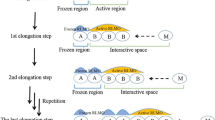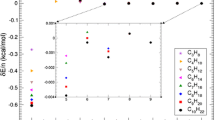Abstract
Geometry optimization using the elongation method is developed at the Hartree–Fock level of theory. The formalism of elongation energy gradient and its accuracy have been validated by model systems calculations. The linear poly-hydrogen fluoride, polyethylene, planar polyacetylene and extended polyalanine are optimized using different basis sets and compared with conventional results. The results show that the elongation Hartree–Fock geometry optimization (ELG-HF-OPT) can reproduce conventional calculation results with high accuracy for various basis sets. For the poly-hydrogen fluoride calculation at 6-31G(d,p) basis set, moreover, ELG-HF-OPT gives a structure with lower ground state energy than conventional results with the same optimization convergence threshold. This means the potential possibility of ELG-HF-OPT can locate a more stable structure than conventional calculations with the same optimization convergence criteria. Therefore, the ELG-HF-OPT would provide one more choice for performing optimization on complicated large systems.




Similar content being viewed by others
References
Szabo A, Ostlund NS (1996) Modern quantum chemistry—introduction to advanced electronic structure theory. Dover Publications lnc, New York
Parr RG, Yang WT (1995) Density-functional theory of the electronic-structure of molecules. Annu Rev Phys Chem 46:701–728
Bartlett RJ (1991) Coupled-cluster theory in atomic physics and quantum-chemistry—introduction and overview. Theor Chim Acta 80:71–79
Bartlett RJ (2000) Perspective on “On the correlation problem in atomic and molecular systems. Calculation of wavefunction components in Ursell-type expansion using quantum-field theoretical methods”—Cizek J (1966) J Chem Phys 45: 4256. Theor Chem Acc 103:273–275
Bartlett RJ, Musial M (2007) Coupled-cluster theory in quantum chemistry. Rev Mod Phys 79:291–352
Cizek J (1966) On the correlation problem in atomic and molecular systems. Calculation of wavefunction components in Ursell-type expansion using quantum-field theoretical methods. J Chem Phys 45:4256–4266
Haser M, Ahlrichs R, Baron HP, Weis P, Horn H (1992) Direct computation of 2nd-order SCF properties of large molecules on workstation computers with an application to large carbon clusters. Theor Chim Acta 83:455–470
Choi CH, Ivanic J, Gordon MS, Ruedenberg K (1999) Rapid and stable determination of rotation matrices between spherical harmonics by direct recursion. J Chem Phys 111:8825–8831
Choi CH, Ruedenberg K, Gordon MS (2001) New parallel optimal-parameter fast multipole method (OPFMM). J Comput Chem 22:1484–1501
Choi CH (2004) Direct determination of multipole moments of Cartesian Gaussian functions in spherical polar coordinates. J Chem Phys 120:3535–3543
Burant JC, Scuseria GE, Frisch MJ (1996) A linear scaling method for Hartree-Fock exchange calculations of large molecules. J Chem Phys 105:8969–8972
Schwegler E, Challacombe M (1996) Linear scaling computation of the Hartree-Fock exchange matrix. J Chem Phys 105:2726–2734
Challacombe M, Schwegler E (1997) Linear scaling computation of the Fock matrix. J Chem Phys 106:5526–5536
Ochsenfeld C, White CA, Head-Gordon M (1998) Linear and sublinear scaling formation of Hartree-Fock-type exchange matrices. J Chem Phys 109:1663–1669
Schwegler E, Challacombe M (1999) Linear scaling computation of the Fock matrix. IV. Multipole accelerated formation of the exchange matrix. J Chem Phys 111:6223–6229
Gan CK, Tymczak CJ, Challacombe M (2004) Linear scaling computation of the Fock matrix. VII. Parallel computation of the Coulomb matrix. J Chem Phys 121:6608–6614
Kohn W (1996) Density functional and density matrix method scaling linearly with the number of atoms. Phys Rev Lett 76:3168–3171
Yang W (1991) Direct calculation of electron density in density-functional theory. Phys Rev Lett 66:1438–1441
Yang WT, Lee TS (1995) A density-matrix divide-and-conquer approach for electronic-structure calculations of large molecules. J Chem Phys 103:5674–5678
Akama T, Kobayashi M, Nakai H (2007) Implementation of divide-and-conquer method including Hartree-Fock exchange interaction. J Comput Chem 28:2003–2012
Kobayashi M, Imamura Y, Nakai H (2007) Alternative linear-scaling methodology for the second-order Moller-Plesset perturbation calculation based on the divide-and-conquer method. J Chem Phys 127:074103
Kitaura K, Ikeo E, Asada T, Nakano T, Uebayasi M (1999) Fragment molecular orbital method: an approximate computational method for large molecules. Chem Phys Lett 313:701–706
Fedorov DG, Kitaura K (2004) The importance of three-body terms in the fragment molecular orbital method. J Chem Phys 120:6832–6840
Fedorov DG, Kitaura K (2004) On the accuracy of the 3-body fragment molecular orbital method (FMO) applied to density functional theory. Chem Phys Lett 389:129–134
Fedorov DG, Kitaura K (2007) Extending the power of quantum chemistry to large systems with the fragment molecular orbital method. J Phys Chem A 111:6904–6914
Mochizuki Y, Koikegami S, Nakano T, Amari S, Kitaura K (2004) Large scale MP2 calculations with fragment molecular orbital scheme. Chem Phys Lett 396:473–479
Mochizuki Y, Fukuzawa K, Kato A, Tanaka S, Kitaura K, Nakano T (2005) 1A configuration analysis for fragment interaction. Chem Phys Lett 410:247–253
Mochizuki Y, Ishikawa T, Tanaka K, Tokiwa H, Nakano T, Tanaka S (2006) Dynamic polarizability calculation with fragment molecular orbital scheme. Chem Phys Lett 418:418–422
Mochizuki Y, Yamashita K, Murase T, Nakano T, Fukuzawa K, Takematsu K, Watanabe H, Tanaka S (2008) Large scale FMO-MP2 calculations on a massively parallel-vector computer. Chem Phys Lett 457:396–403
Deev V, Collins MA (2005) Approximate ab initio energies by systematic molecular fragmentation. J Chem Phys 122:154102
Collins MA, Deev VA (2006) Accuracy and efficiency of electronic energies from systematic molecular fragmentation. J Chem Phys 125:104104
Addicoat MA, Collins MA (2009) Accurate treatment of nonbonded interactions within systematic molecular fragmentation. J Chem Phys 131:104103
Mullin JM, Roskop LB, Pruitt SR, Collins MA, Gordon MS (2009) Systematic fragmentation method and the effective fragment potential: an efficient method for capturing molecular energies. J Phys Chem A 113:10040–10049
Imamura A, Aoki Y, Maekawa K (1991) A theoretical synthesis of polymers by using uniform localization of molecular-orbitals—proposal of an elongation method. J Chem Phys 95:5419–5431
Aoki Y, Imamura A (1992) Local density of states of aperiodic polymers using the localized orbitals from an abinitio elongation method. J Chem Phys 97:8432–8440
Gu FL, Aoki Y, Korchowiec J, Imamura A, Kirtman B (2004) A new localization scheme for the elongation method. J Chem Phys 121:10385–10391
Roothaan CCJ (1951) New developments in molecular orbital theory. Rev Mod Phys 23:69–89
Kohn W, Sham LJ (1965) Self-consistent equations including exchange and correlation effects. Phys Rev 140:1133–1138
Schmidt MW, Baldridge KK, Boatz JA, Elbert ST, Gordon MS, Jensen JH, Koseki S, Matsunaga N, Nguyen KA, Su SJ, Windus TL, Dupuis M, Montgomery JA (1993) General atomic and molecular electronic-structure system. J Comput Chem 14:1347–1363
Aoki Y, Suhai S, Imamura A (1994) An efficient cluster elongation method in density-functional theory and its application to poly-hydrogen-bonding molecules. J Chem Phys 101:10808–10823
Pomogaeva A, Kirtman B, Gu FL, Aoki Y (2008) Band structure built from oligomer calculations. J Chem Phys 128:074109
Pomogaeva A, Springborg M, Kirtman B, Gu FL, Aoki Y (2009) Band structures built by the elongation method. J Chem Phys 130:194106
Ohnishi S, Orimoto Y, Gu FL, Aoki Y (2007) Nonlinear optical properties of polydiacetylene with donor-acceptor substitution block. J Chem Phys 127:084702
Chen W, Yu GT, Gu FL, Aoki Y (2009) Investigation on the electronic structures and nonlinear optical properties of pristine boron nitride and boron nitride-carbon heterostructured single-wall nanotubes by the elongation method. J Phys Chem C 113:8447–8454
Yan LK, Pomogaeva A, Gu FL, Aoki Y (2010) Theoretical study on nonlinear optical properties of metalloporphyrin using elongation method. Theor Chem Acc 125:511–520
Pomogaeva A, Gu FL, Imamura A, Aoki Y (2010) Electronic structures and nonlinear optical properties of supramolecular associations of benzo-2,1,3-chalcogendiazoles by the elongation method. Theor Chem Acc 125:453–460
Aoki Y, Loboda O, Liu K, Makowski M, Gu F (2011) Highly accurate O(N) method for delocalized systems. Theor Chem Acc 130:595–608
Makowski M, Korchowiec J, Gu FL, Aoki Y (2006) Efficiency and accuracy of the elongation method as applied to the electronic structures of large systems. J Comput Chem 27:1603–1619
Lowdin P-O (1950) On the non-orthogonality problem connected with the use of atomic wave functions in the theory of molecules and crystals. J Chem Phys 18:365–375
Korchowiec J, Gu FL, Imamura A, Kirtman B, Aoki Y (2005) Elongation method with cutoff technique for linear SCF scaling. Int J Quantum Chem 102:785–794
Korchowiec J, Lewandowski J, Makowski M, Gu FL, Aoki Y (2009) Elongation cutoff technique armed with quantum fast multipole method for linear scaling. J Comput Chem 30:2515–2525
Korchowiec J, De Silva P, Makowski M, Gu FL, Aoki Y (2010) Elongation cutoff technique at Kohn–Sham level of theory. Int J Quantum Chem 110:2130–2139
Vreven T, Morokuma K, Farkas O, Schlegel HB, Frisch MJ (2003) Geometry optimization with QM/MM, ONIOM, and other combined methods. I. Microiterations and constraints. J Comput Chem 24:760–769
Wang B, Truhlar DG (2010) Combined quantum mechanical and molecular mechanical methods for calculating potential energy surfaces: tuned and balanced redistributed-charge algorithm. J Chem Theory Comput 6:359–369
Wang B, Truhlar DG (2011) Geometry optimization using tuned and balanced redistributed charge schemes for combined quantum mechanical and molecular mechanical calculations. Phys Chem Chem Phys 13:10556–10564
Helgaker T, Jorgensen P, Olsen J (2000) Molecular electronic-structure theory. John Wiley & Sons Ltd., West Sussex
Spartan’10 Wavefunction. Inc. Irvine, CA
Humphrey W, Dalke A, Schulten K (1996) VMD: visual molecular dynamics. J Mol Graph 14:33–38
Nagata T, Fedorov DG, Kitaura K (2009) Derivatives of the approximated electrostatic potentials in the fragment molecular orbital method. Chem Phys Lett 475:124–131
Aoki Y, Gu FL (2012) An elongation method for large systems toward bio-systems. Phys Chem Chem Phys 14:7640–7668
Acknowledgments
K. L. was supported by the JST-RA system by the group CREST, Japan Science and Technology Agency (JST) and the Kuma Toshimi international scholarship of Interdisciplinary Graduate School of Engineering Sciences at Kyushu University. K. L. thanks D. R. Price for assistance in revising in the manuscript. The calculations were performed on the Linux PC cluster in our laboratory and the high performance computing systems of the Research Institute for Information Technology at Kyushu University. T. I. was financially supported by China Postdoctoral Science Foundation.
Author information
Authors and Affiliations
Corresponding authors
Electronic supplementary material
Below is the link to the electronic supplementary material.
Rights and permissions
About this article
Cite this article
Liu, K., Inerbaev, T., Korchowiec, J. et al. Geometry optimization for large systems by the elongation method. Theor Chem Acc 131, 1277 (2012). https://doi.org/10.1007/s00214-012-1277-9
Received:
Accepted:
Published:
DOI: https://doi.org/10.1007/s00214-012-1277-9




